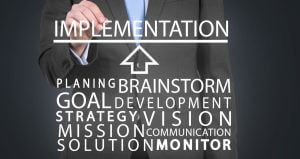“What is at the heart of any ERP system?” “It is the ability to centralize and streamline business operations by integrating key functions like finance, manufacturing, and logistics.” This makes it possible to manage and analyze data more effectively, make better decisions, and automate business processes.
What is at the heart of any ERP system are, in addition to a flexible software architecture, correct implementation and deployment, measures of security and compliance, and continuing maintenance and support.
What Is At The Heart Of Any ERP System Includes ERP System Components

In an ERP system, data for all business functions, like finance, production, and inventory management, is kept in a central database. ERP software modules employ this data to provide real-time operational visibility. ERP system parts include
-
Financial Management

Budgeting and reporting are all aspects of managing financial transactions.
-
Supply chain Management

Managing the flow of goods and services, including procurement, manufacturing, and logistics
-
Customer Relationship Management

Managing customer interactions, including sales, marketing, and customer service
-
Business Intelligence

analyzing data to gain insights and make informed decisions.
-
Inventory Control

Inventory management, replenishment, and cost control Project management entails overseeing project timelines, resources, and expenses.
-
Human Resource Administration

managing employee information, payroll, and benefits.
Aside from these, many ERP systems feature capabilities for integration, customization, and reporting. ERP systems are made to connect all of these operations, which gives an organization a single source of truth for its data and makes it more efficient and better at making decisions.
What Is At The Heart Of Any ERP System Includes ERP Maintenance And Support

Maintenance and support for ERP (Enterprise Resource Planning) are the ongoing tasks and services that are needed to make sure that an ERP system continues to work well and meet the needs of the organization. What is at the heart of any ERP system can include updating software, making backups of data, troubleshooting and fixing problems, and giving users training and help.
The ERP system or a third-party service can perform maintenance and support. An ERP maintenance and support plan must be in place for an organization to make sure that the system stays stable and useful over time.
What Is At The Heart Of Any ERP System Is The Ability To Automate And Streamline Business

At the heart of any ERP (enterprise resource planning) system is the ability to automate and streamline business operations. An ERP system can help a business manage and automate a wide range of business tasks, such as finance, accounting, human resources, and supply chain management. By putting all of an organization’s different operations into one system, an ERP system can help improve efficiency, cut costs, and boost productivity.
Also, an ERP system can give real-time visibility and insights into how a company is doing, which helps companies figure out where they can improve and make better decisions. This can aid in resource optimization, collaboration, communication, and work efficiency. Overall, an ERP system is a great solution for firms that want to automate their operations while improving their bottom line.
What Is At The Heart Of Any ERP System: Data Management In ERP Systems

What is at the heart of any ERP system is the process of putting the system’s data in order and keeping it safe. This comprises duties such as data entry, data updating, and data correctness and consistency. Data management is an important part of ERP systems because the system’s effectiveness is dependent on the quality and accuracy of the data. Typically, information is divided into modules like finance, human resources, and inventory management.
Each module requires its own set of data fields and tables to be managed. Data analysis also encompasses data security, protection, backup, and recovery. Data warehouses and data integration with other systems are also important parts of managing data in ERP systems.
What Is At The Heart Of Any ERP System Includes ERP Software Architecture

At the heart of any ERP (enterprise resource planning) system is a central database that keeps track of data for all of an organization’s business operations, such as finance, manufacturing, and inventory management. Multiple ERP software modules then use this information to show what’s going on in the company in real time. The architecture of ERP software is usually made up of three layers: the user interface layer, the business logic layer, and the data layer.
The business logic layer processes data and makes calculations, while the user interface layer lets users interact with the ERP system. The data layer stores and manages the data of the organization. Also, many ERP systems have a fourth layer called the integration layer. This layer makes it possible for the ERP system to work with other systems like e-commerce platforms and CRM systems.
ERP Implementation And Deployment

Implementing and deploying an ERP system is called ERP implementation and deployment. Planning, analysis, design, testing, and deployment are usually required for this lengthy procedure.
What is at the heart of any ERP system is the process of ERP implementation, which begins with planning. This involves determining the company’s needs and selecting the best ERP system. This includes determining hardware, software, people, and project schedules.
Next, the organization’s business operations are analyzed to determine areas where an ERP system could help. This includes mapping current processes and determining if adjustments or integrations are needed.
The ERP system is customized during design. This includes configuring system modules, features, data formats, and security procedures.
Conclusion
What is at the heart of any ERP system is a database that is located in one place and has information about all of an organization’s business operations. What is at the heart of any ERP system is the process of integrating multiple ERP software modules, which then use this information to show what’s going on in the company in real time. The ERP system is meant to bring together all of the organization’s functions, such as finance, manufacturing, inventory management, human resources, customer relationship management, and project management.
This integration improves the business’s performance and growth by making it more efficient and helping it make better decisions. Also, the architecture of ERP software usually has three layers: a user interface layer, a business logic layer, and a data layer. Some systems also have an integration layer.

